The German women’s movement creates publicity with imaginative and provocative campaigns. Homosexual women, having previously been co-operating with men, now join the feminists.
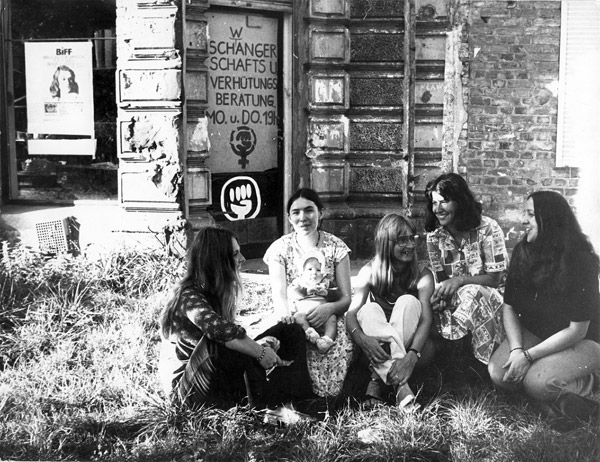
January 1973
Around 40 women’s groups from Brot und Rosen in Berlin to Interessenkreis Frauenemanzipation in Wiesbaden, from F.R.A.U. to S.O.F.A. have been founded. Here is a list of women’s groups.
Germany’s first women’s center opens in Berlin. It is founded by about 120 women in the Kreuzberger Hornstraße 2, initiated mainly by the group „ Brot und Rosen“ and the women’s group of the Homosexuelle Aktion West Berlin (HAW). With the foundation of the center, the HAW women are increasingly detaching themselves from the homosexual men and are turning to cooperation with the women’s center groups instead. From March 24, 1973, the center is open daily. See flyer
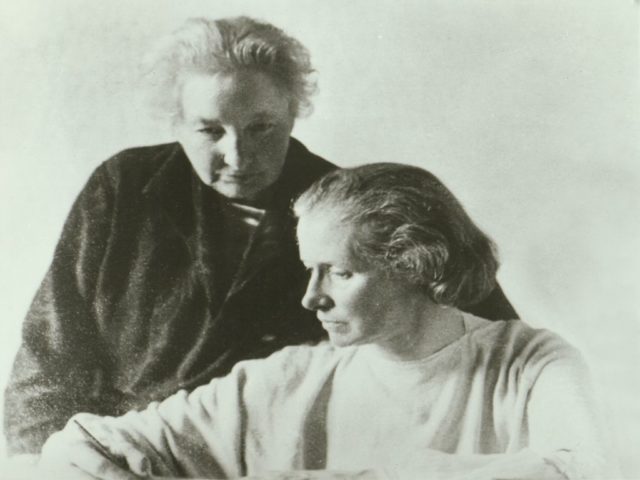
The activists of the New Women’s Movement had predecessors: 76 years before them, the women’s rights activists around Anita Augspurg and Lida Gustava Heymann already recognized „that we absolutely had to have our own house“ (read more). So in 1897 they opened a women’s center in Paulstraße 25, Hamburg.
10th-12th February 1973
Around 30 women’s groups from all over Germany as well as Paris and Amsterdam attend the Federal Women’s Meeting in Munich. Topics are strikes against the so-called light-wage groups, the separation from / cooperation with men in the movement and of course the fight against § 218. Annie Cohen and Alice Schwarzer of the Paris MLF attend the congress together with the French doctor Friedman, known to feminists and doctors alike for applying the Karman method (suction method) – the gentlest abortion method, which is not yet used in Germany.
Following the US-American example, German feminists are now also practicing ‚Consciousness Raising‘ (CR): in self-reference groups, they talk about the private, which is also political.
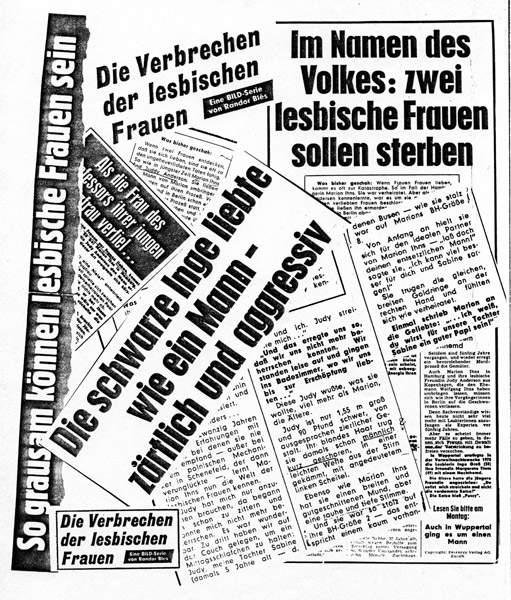
February 17, 1973
The HAW women’s group launches a protest against a series on „The crimes of lesbian women“ in the tabloid newspaper Bild, which is based on the arrest of Marion Ihns and Judy Andersen. The two women were a couple and had hired a contract killer to get rid of Ihns’ abusive husband. The Bild series is intended as a punch against revolting women in general – homosexual and heterosexual women alike. „Readers, especially female readers, should be indoctrinated with this series. It implied that women who do not want to accept their role in society as a good wife and mother, can only be criminal anyway,“ writes the HAW in a leaflet. For the first time since the beginning of the New Women’s Movement, lesbian women protest publicly against discrimination and criminalization.
End of February 1973
Around 50 young female pupils, apprentices and students storm the beauty contest Miss Teenage Legs in the Frankfurt discotheque Number One with pork knuckles and leaflets from the women’s group Revolutionärer Kampf. Motto: „You are selling our knees here like the farmer is selling a piece of cattle!“ The campaign is one of the first public protests against everyday sexism.
![Frauenarbeit - Frauenbefreiung : Praxis-Beispiele und Analysen (1973). - Schwarzer, Alice [Hrsg.]. 1. Aufl. - Frankfurt am Main : Suhrkamp (FMT-Signatur: AR.07.040-1973). Frauenarbeit - Frauenbefreiung : Praxis-Beispiele und Analysen (1973). - Schwarzer, Alice [Hrsg.]. 1. Aufl. - Frankfurt am Main : Suhrkamp (FMT-Signatur: AR.07.040-1973).](http://frauenmediaturm.de/wp-content/uploads/2018/06/Schwarzer_Frauenarbeit_Frauenbefreiung-e1530270482391-418x640.jpg)
Spring of 1973
Edition Suhrkamp publishes Alice Schwarzer’s second book: Frauenarbeit – Frauenbefreiung [Women’s work – women’s liberation]. Once again the author works with the method of condensed monologues (protocols), from the supermarket cashier to the filmmaker. Essays analyze the conflict of women between work and family. And in the appendix, all known addresses of autonomous women’s groups are published. There are 42 in West Germany and West Berlin, and two each in Austria and Switzerland.
March 8, 1973
Women’s groups in Frankfurt, from Weiberrat to University groups and Revolutionärer Kampf start fighting sexism. They spray boutique shop windows („We are no dolls!“) And call for a go-in in the Polyclinic, the deletion of § 218, abortion on medical certificate and the free pill. They also demand for rooms for a women’s center.
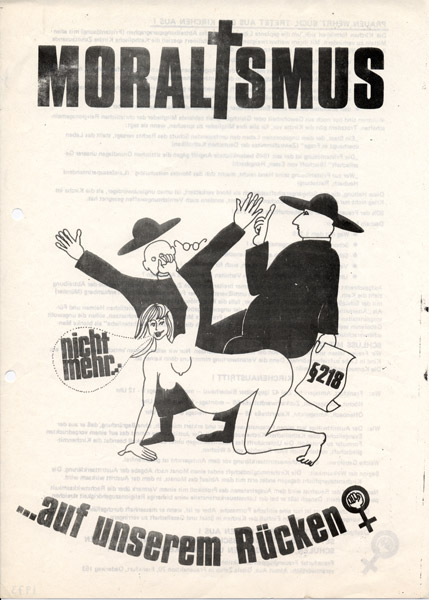
End of March 1973
Women’s groups respond to the harsh anti-abortion policies of the Catholic Church and launch a church exit campaign. „Can we continue to take on the responsibility of funding a male institution that denies us women the chance to work, to receive training and to prevent pregnancy, in short: that forces us to stay in the house forever, for cooking and childcare and being forced to have children?“
At the reading of the pastoral letter to § 218, about 100 women storm the Frankfurt Cathedral and drown out the reading with their chants („unborn is protected – the born is exploited!“). The police take 31 women and 20 men into custody.
April 14, 1973
With flour bags, cooked noodles and baby powder around 70 women blow up the annual general meeting of the Hessian Hartmannbund in Oberursel. The conservative physicians‘ organization had spoken out sharply against the ‘Fristenlösung’ several times and even blocked the gentle Karman method. In a survey of the Bild newspaper, 63 percent of the doctors surveyed (including the Hartmannbund) said they were not prepared to make abortions without medical necessity.
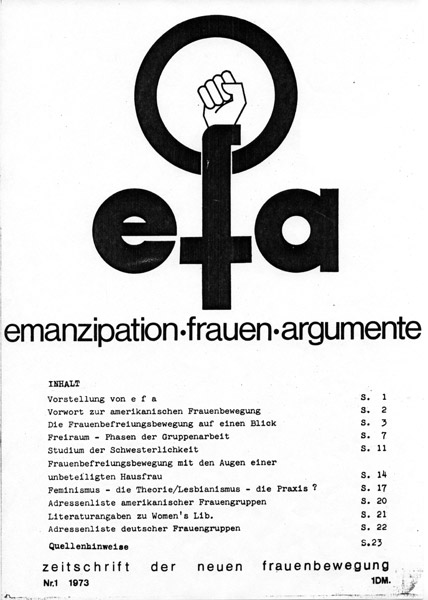
May 1973
All over Germany, women’s groups launch campaigns on Mother’s Day. Motto: „We want rights – not roses!“ See: Flyer
5th-6th May 1973
At the Delegates Conference in Frankfurt, 37 women’s groups from all over Germany take part. A conflict flares up with regard to the first edition of the newspaper efa, which is published by the Socialist Women’s Group Cologne (S.O.F.A.). However, most of the participants advocate an autonomous newspaper that is to be edited alternately by various women’s groups. The dispute illustrates the increasing tensions between the autonomous-feminist and socialist-feminist positions.
May 15, 1973
The time of squatters. Mostly, young people from the „scene“ occupy vacant homes (often objects of speculators) to create cheap living space. Women’s groups are also beginning to occupy houses. In Berlin, the first squatting of women is ended by a Hundred police officers and with two water cannons. A group of young women – students and employees – had lived in a vacant apartment in Freiherr-vom-Stein-Straße as a „women’s collective“.
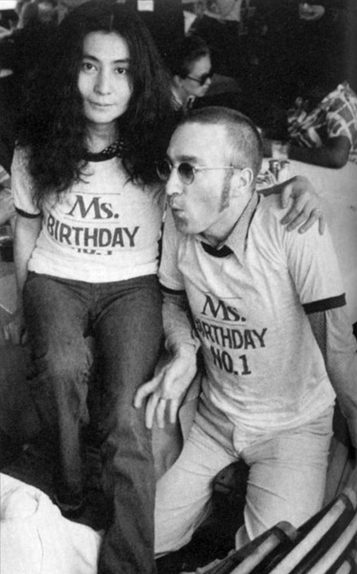
June 2, 1973
At a mass demonstration in Bonn, women from all over Germany demand the ‘Fristenlösung’. The Bundestag wants to decide in the course of the year over a § 218 reform. The chancellor’s name is Willy Brandt, a red-yellow coalition is in power. According to surveys, 83 percent of all German women oppose the abortion ban. But the SPD hesitates. The FDP, however, is in favor of the ‘Fristenlösung’.
June 4, 1973
The National Organization for Women (NOW) invites to the 1st International Feminist Planning Conference to Cambridge / USA (only male participant: John Lennon, on the side of Yoko Ono). The 300 participants from all over the world decide to hold a first international feminist women’s conference next year in Belgium or Sweden, in view of the women’s UN year planned for 1975.
Pentecost 1973
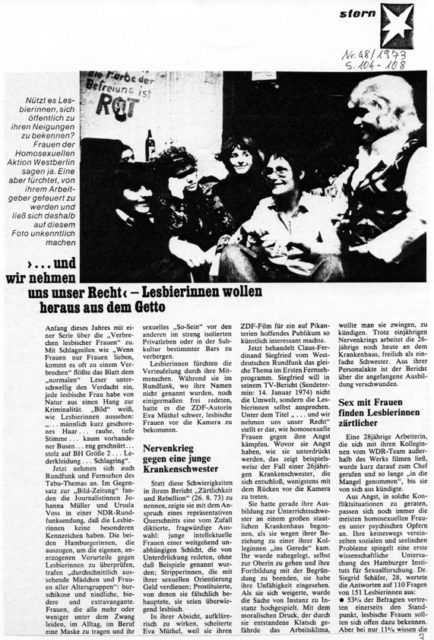
At the second supraregional Pentecost meeting of the HAW, for the first time the women’s group initiates its own events, in which around 50 women also take part. The lesbian women found a working group entitled, „The Need for Lesbians to Become Feminist“ and declare: “ In our patriarchal society, women – especially gay women – are not considered independent subjects capable of realizing their interests but they remain the object and object of desire of men. The gay women must recognize the function of the standardized role behavior of the sexes, detach themselves from these stereotypes and proceed against them.“ – During the meeting, the ZDF television film Zärtlichkeit und Rebellion is filmed (author: Eva Müthel).
July 1973
Berlin women’s groups launch the postcard campaign ‚Woman in Advertising‘ against sexist commercials. They urge Sender Freies Berlin as a public service institution to „stop providing airtime for discrimination against women!“
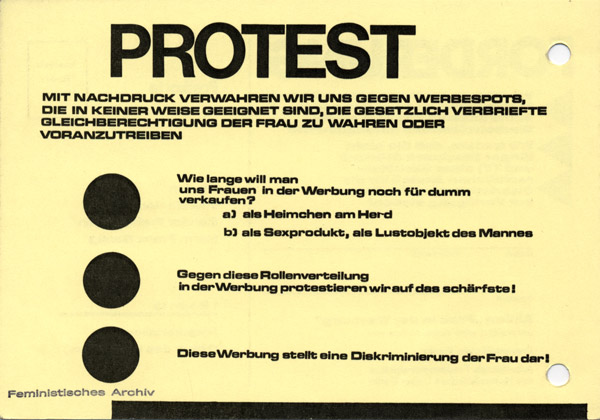
The Bundestag decides the fourth sexual criminal law reform, which among other things allows for the release of „simple“ pornography to adults. At first feminists welcome this step as „sexual liberation“. Two years later, however, on the occasion of the film History of the O, there will be the first anti-porn protests against the consequences of the reform.
Within the SPD the Association of Social Democratic Women (AsF) is founded. The first AsF federal congress takes place in Ludwigshafen. Motto: ‚Overcome discrimination‘.
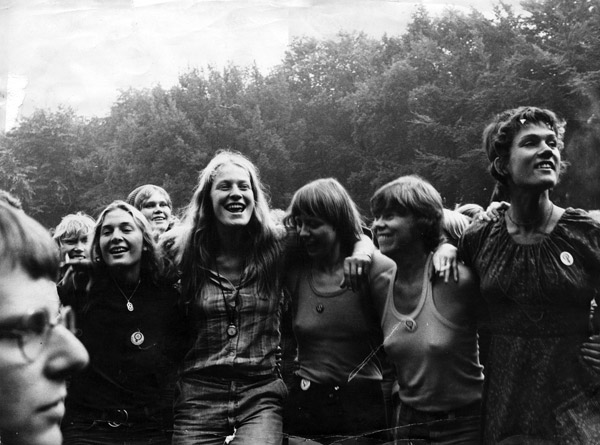
Summer of 1973
On the Danish island of Femø, women from many European countries meet for the first international women’s tent camp. The summer meeting initiated by Scandinavian feminists is quickly becoming legendary. Women from all over Europe, even from the USA, will travel summer after summer in the coming years to enjoy life in the Frauenland for a few weeks. First dreams of past ‚matriarchies‘ and future ‚women’s land‘ are turning up. The first tensions between the ’separatists‘ and the activists emerge: the former want to break away completely from ‚the men‘ and retire to the women’s domain. The second want to continue influencing society and to work towards the equality of women and men.

A wave of women’s strikes breaks out. On 16 July, nearly 4,000 workers from the Lippstadt Hellawerke go on strike. The trigger was a wage increase in the toolmaking sector, which only benefited the men. The (mostly foreign) women of the low wage groups went out of business. On August 13, 2,000 workers of the Neuss carburetor factory Pierburg strike for a salary increase by one mark per hour and the abolition of the light wage group 2. The women, including about 1,600 Turkish, Greek and Italian women win the labor dispute. In Herne Optal-Werke, 30 workers win a price-inflation supplement. In Cologne, seamstresses are successfully protesting against increasing the pace of work
It is the time when leftists from Maoist, spontaneousist and communist factions said the theory adé and get practically involved. Many of them went to the factories, assembly lines and workbenches. Goal: The ‚agitation of the proletariat‘. Among these agitators are women too – and they are primarily directed to the female proletariat. The strikes are not always, but sometimes initiated or co-organized by them.
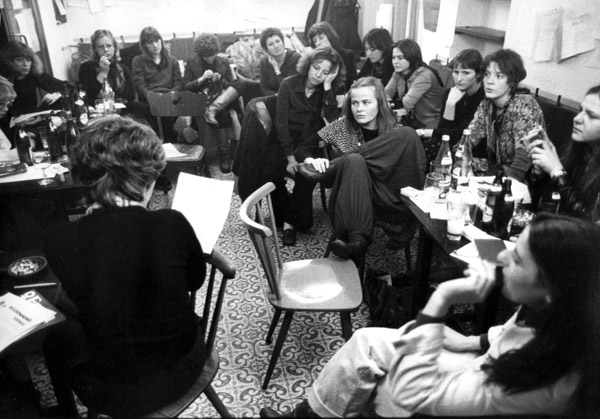
September 1973
In Frankfurt another women’s center opened. It is the second in Germany. Initiators are above all the Weiberrat and the Frauengruppe Revolutionärer Kampf. The founders announce the lifting of the isolation of women, women’s literacy groups, CR groups and self-examination.
October 1973
The feminist newspaper Frauenzeitung – Frauen gemeinsam sind stark appears. The topics range from contraception and § 218 to lesbians, women’s strikes in France and experiences in Femo. The “ Frauenzeitung “ is produced alternately by groups of women from different cities and appears eight times until 1976.
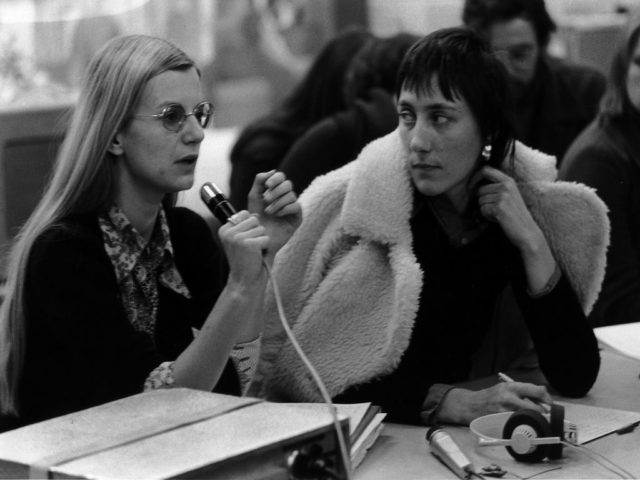
15th-18th November 1973
The 1st International Women’s Film Seminar takes place in the Berlin cinema Arsenal titled „Documentary and target group films on the situation of women“. Organizers are Helke Sander and Claudia von Alemann. The four-day film seminar will cover the following feminist issues: ‚women in labor disputes‘, ‚women in media representation‘, ‚§218, sexuality, role behaviors‘ and ‚women’s movement in Europe and the USA‘.
November 1973
At the Women’s Center in Berlin, two American women from the Women’s Health Center in Los Angeles present a public self-examination with the speculum. 300 female spectators jostle into the crowded Women’s Center in Horn Street.
Two years after it started in the USA, the feminist women’s health movement (EMMA 5/2003) finds its way to Germany with organized self-help groups for questions on contraception, pregnancy, abortion and gynecological diseases. From 1976 the women’s health magazine CLIO is published in Berlin. In 1977, the first Feminist Women’s Health Center (FFGZ) was also opened in Berlin.


